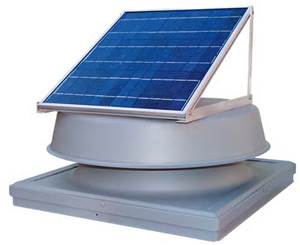|
Residential Attic Ventilation - Solar Powered Ventilation By Pierre Mouchette | Real Property Experts LLC As the sun heats your roof throughout the summer day, attic temperatures can reach over 150 degrees. Having your attic breathe is an integral part of the maintenance of a healthy and energy-efficient home. When your attic cannot breathe, the trapped heat and moisture can cause numerous problems, including higher electric bills, mold outbreaks, and the deterioration of your roof (roof shingles transfer heat to the attic, and they start to buckle and deteriorate over time).
The solution to this ventilation problem is to remove the heat and moisture throughout the day with an automated ventilation system. With a solar-powered ventilation system, you benefit by having a system with no operational costs and a cooler attic without moisture. Questions and Answers about Residential Attic Fans Q. I thought that the insulation that the builder put into the attic prevented heat build-up! A. Attic insulation is the primary method builders use to keep heat from entering the home. This works when the insulation is new, but excessive attic heat and moisture will degrade and compact insulation over time, making it less effective. An attic fan will help to extend the life of installed insulation. Q. How does this affect my air conditioning? A. If HVAC equipment has been installed in the attic space, your cooling system will use more energy to operate in the hotter attic space due to heat gain. By removing heat and reducing the attic temperature, you allow the HVAC system to work more efficiently and use less energy to cool your home. i.e., lowers your energy consumption and equipment maintenance costs. The same thing happens if you use window units, wall units, or HVAC equipment installed outside the home. The less heat build-up in the attic, the less thermal transfer to other parts of the house, and a longer life for your attic insulation and less build-up moisture in the attic. Here again, your energy consumption is less, and your cooling equipment is more efficient. Q. What should you look for? A. The attic ventilator must be a professional-grade engineered product, designed and warranted for a lifetime of service to the homeowner. Unit to be programmed to operate by a digital thermal switch controller offering both safety and operational features for the attic ventilation system. Q. Still confused about selecting a solar-powered ventilation system. A. When comparing solar attic fans, the most important specification to look at is the airflow rating, which is cubic feet per minute (CFM). The CFM rating will tell you the actual performance of the fan regardless of the parts used to make it. Note: Do not forget to ask your dealer about the available Federal Tax Credit! An additional consideration in selecting your solar-powered ventilation system is: Professional Grade A professional-grade product is engineered for a lifetime of durability. It requires the manufacture to use the highest quality parts and materials. Additionally, professional-grade products do not use polymer (plastic) parts to degrade in the harshest weather conditions (extreme winter cold and intense summer heat), season-after-season, year after year. In retrospect, the product must function as it was designed. High-Quality Parts The quality manufactured parts should be
Comments are closed.
|
Archives
May 2024
|
